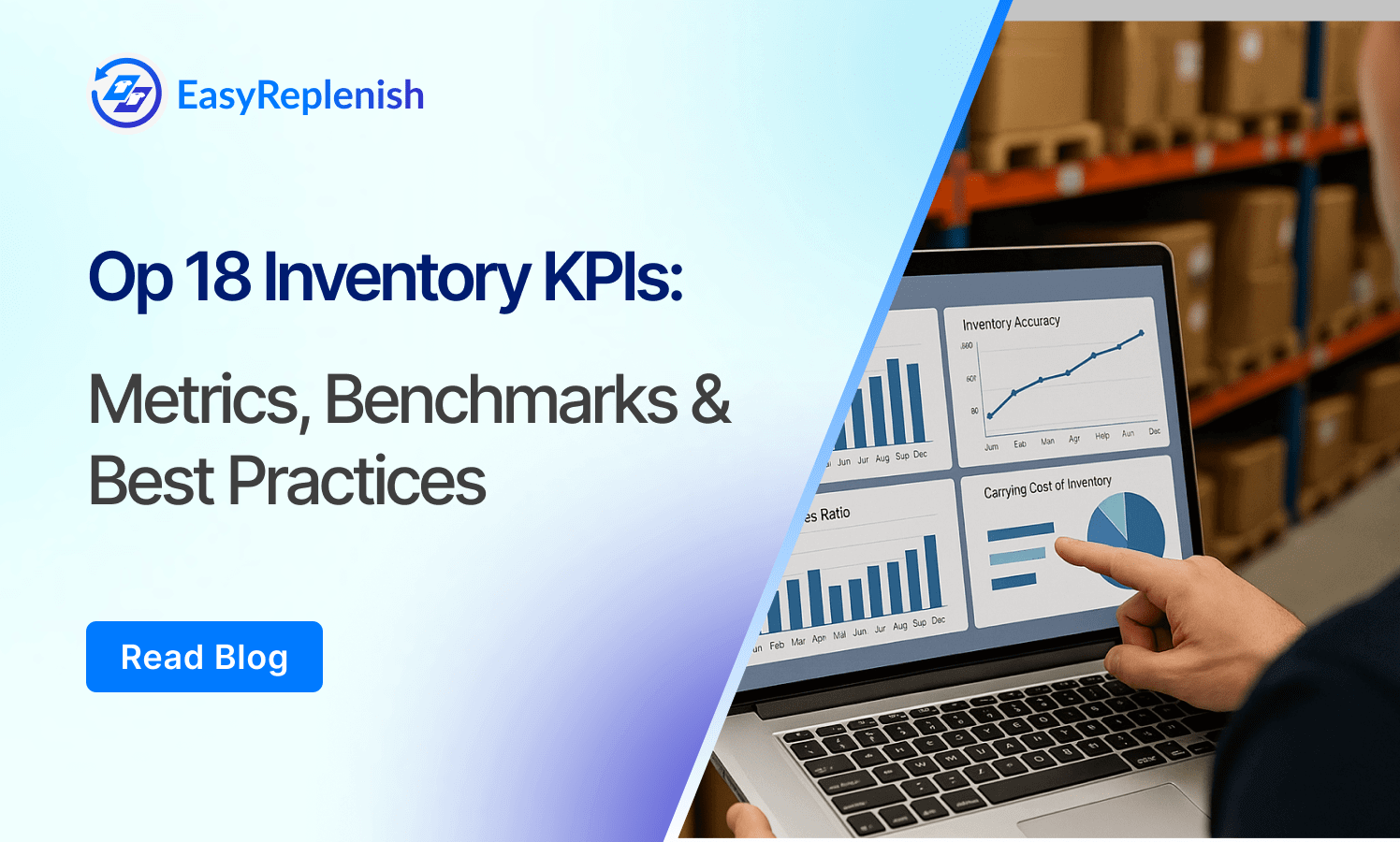How Multi-Warehouse Inventory Optimization Works: A Complete Guide

You don’t optimize multi-warehouse inventory to make things easier.
You do it because not optimizing it is what’s killing your margins.
When you're managing stock across 3, 5, or even 15 warehouses, decisions that once seemed small—like where to store 300 units of your top seller—can snowball into massive fulfillment delays, stockouts in one region, and overstock in another. All while your carrying costs quietly eat away at your profits.
Multi-warehouse inventory optimization isn’t just a “nice-to-have” for growing brands, 3PLs, or distributors—it’s the only way to run lean, fulfill faster, and scale without chaos.
This guide breaks down how optimization actually works:
- How to think beyond static replenishment rules
- What data you need to make smarter distribution decisions
- The math (and tech) behind optimal stock allocation
- How leading businesses use it to reduce deadstock and shorten delivery times
If you’re still treating every warehouse the same, this blog will show you how to change that—and why your future inventory performance depends on it.
What is Multi-Warehouse Inventory Optimization?
Multi-warehouse inventory optimization is the process of strategically distributing your inventory across multiple storage locations—using data, demand patterns, and cost variables—to maximize availability while minimizing excess and inefficiencies.
But let’s be clear: it’s not just splitting your stock evenly across warehouses.
It’s about answering questions like:
- Where should each SKU live to serve demand fastest and cheapest?
- How much safety stock should each location carry, based on local demand volatility?
- What’s the ideal reorder point when inventory is decentralized?
At its core, this approach aims to balance stock availability, fulfillment speed, and operational costs across your entire distribution network. The more warehouses you have, the more complex this equation gets—and the more important optimization becomes.
Done right, it means:
- Fewer split shipments and lower shipping costs
- Higher in-stock rates at regional warehouses
- Reduced overstock and dead inventory
- Faster delivery SLAs with fewer fulfillment errors
And behind it all is a dynamic model—often powered by AI or advanced planning systems—that continuously analyzes demand signals, lead times, and capacity constraints to recommend the best distribution of stock.
How Multi-Warehouse Inventory Optimization Works (Step-by-Step)
Optimizing inventory across multiple warehouses isn’t a single action—it’s an ongoing system built on data, forecasting, prioritization, and automation.
Here’s a step-by-step breakdown of how the process works:
1. Centralized Data Consolidation
Before you optimize, you need to unify the mess.
Pull in data from:
- Sales channels (DTC, B2B, marketplaces)
- Warehouse management systems (WMS)
- Demand forecasts by region or customer segment
- Historical lead times and replenishment patterns
- Real-time inventory levels by SKU-location
Why it matters: Optimization is only as good as the data feeding it. If your systems don’t talk to each other, you’re flying blind.
2. Demand Forecasting by Location
One-size-fits-all forecasting breaks here.
Instead, use location-specific forecasting:
- Analyze regional buying trends
- Consider seasonality, promotions, and local demand spikes
- Factor in channel mix (e.g., retail vs online demand)
Example: If black sneakers sell 4x more in the Northeast during Q4, your forecast must reflect that—warehouse stock allocation should too.
3. Inventory Segmentation (ABC Analysis by Location)
Not all products are equal. And not all warehouses should treat them the same.
Segment inventory by:
- Velocity: Fast, medium, slow movers
- Margin contribution
- Criticality (stockout cost vs holding cost)
This helps determine:
- What SKUs get priority stocking
- Where buffer inventory is worth the carrying cost
- Which items can be pooled centrally vs distributed
4. Optimal Stock Allocation & Distribution Modeling
Now comes the core of optimization: determining how much of each SKU should go where.
This includes:
- Safety stock calculations per location based on local volatility
- Lead time variability by supplier and destination
- Storage capacity and cost constraints at each warehouse
- Proximity to demand zones (for faster shipping, lower cost)
Tools involved:
Inventory optimization software, prescriptive analytics, constraint-based models, or even AI-powered allocation engines.
5. Replenishment Strategy & Transfer Logic
Once stock is distributed, it won’t stay optimal forever. You need smart replenishment.
This includes:
- Dynamic reorder points per warehouse (based on actual velocity and forecast)
- Automated inter-warehouse transfers when stock is misaligned
- Trigger-based replenishment logic (e.g., stock falls below X → pull from nearby warehouse or reorder from supplier)
This prevents overstock in one place while another warehouse is stocked out.
6. Continuous Monitoring & Optimization Loop
Optimization is not a set-it-and-forget-it system.
You need to:
- Track key KPIs (fill rate, split shipment %, order cycle time, inventory turns)
- Adjust based on new data (sales surges, shipping delays, warehouse closures, etc.)
- Re-forecast weekly or monthly depending on volatility
The best systems self-learn—they get smarter as more demand and inventory data flows through.
Example: How a Fashion Brand Scaled Fulfillment with Multi-Warehouse Optimization
Brand: Noir Atelier – A fast-growing D2C and wholesale fashion brand
Inventory Setup: 4 regional warehouses – East Coast (US), West Coast (US), EU (Netherlands), and India (production + fulfillment)
Problem: Frequent stockouts in high-demand zones, high split-shipment costs, and slow cross-border deliveries
The Challenge
Noir Atelier expanded rapidly across the US and Europe, but their inventory planning couldn’t keep up.
Here’s what they were facing:
- Same-stock allocation across all warehouses, ignoring regional demand
- Split shipments for over 30% of US orders, raising logistics costs by 22%
- Stockouts in the EU warehouse while excess sat idle in the US
- No system for prioritizing high-margin SKUs during global launches
The result? Slower fulfillment, lower conversion rates during restocks, and shrinking profit margins due to excess logistics spend
The Optimization Strategy
To fix it, they implemented a multi-warehouse inventory optimization system using a combination of WMS, demand forecasting, and inventory planning tools.
Step 1: Unified Data Layer
- Connected Shopify, ERP, WMS, and 3PL tools to create real-time SKU-location visibility
- Consolidated order velocity by ZIP code, warehouse, and channel
Step 2: Regional Demand Forecasting
- Identified that oversized blazers had 60% higher demand on the US East Coast
- Found that pastel-colored SKUs were top performers in the EU during spring launches
Step 3: Stock Allocation Redesign
- Allocated inventory based on regional sell-through rates
- Increased safety stock of fast movers in each region (buffer of 2 weeks vs global average)
- Held low-velocity SKUs centrally in India to reduce carrying costs
Step 4: Replenishment + Transfer Logic
- Automated intra-warehouse transfers when demand outpaced local availability
- Switched to dynamic reorder points using a 4-week rolling forecast per warehouse
Results
After three months of rollout:
- Split shipments dropped by 68%, cutting logistics cost per order by 18%
- Stockouts reduced by 47% in regional warehouses during peak campaigns
- Inventory turnover improved by 31% in the EU warehouse
- Order-to-ship time dropped by 2.1 days on average across all markets
Top KPIs to Measure Multi-Warehouse Inventory Optimization Performance
You can’t optimize what you don’t measure.
Tracking the right metrics across all your warehouses helps you understand if your inventory is in the right place, at the right time, and moving at the right pace.
Here are the most critical KPIs to monitor:
1. Inventory Turnover Ratio (By Warehouse)
Formula:
Inventory Turnover = Cost of Goods Sold / Average Inventory
Why it matters:
Shows how efficiently inventory is selling at each warehouse. A low turnover may indicate overstock; too high means potential stockouts.
Use to rebalance inventory or flag slow-moving SKUs by location.
2. Fill Rate (Order Line Fill Rate or SKU Fill Rate)
Formula:
(Fulfilled Order Lines / Total Order Lines) x 100
Why it matters:
Measures your ability to fulfill customer orders from existing stock—critical for customer satisfaction and SLA compliance.
Track per warehouse to identify stock placement gaps.
3. Split Shipment Rate
Formula:
(Orders Shipped from Multiple Warehouses / Total Orders) x 100
Why it matters:
Split shipments increase shipping costs and complexity. A high rate usually points to poor stock allocation or imbalanced inventory levels.
Lower this to improve fulfillment efficiency and margin.
4. Stockout Rate (By SKU or Warehouse)
Formula:
(Out-of-Stock Days / Total Days) x 100 or
(Unfulfilled Demand / Total Demand) x 100
Why it matters:
Reveals missed sales and service-level breaches. High rates = lost revenue and unhappy customers.
Use to improve safety stock and location-based forecasts.
5. Carrying Cost of Inventory (By Warehouse)
Formula:
Carrying Cost = Inventory Value x Carrying Cost % (typically 20–30%)
Why it matters:
Shows how much it costs to hold inventory—varies by warehouse depending on rent, labor, utilities, etc.
Useful for ROI analysis on decentralization vs centralization
6. Days on Hand (DOH) or Days in Inventory
Formula:
(Average Inventory / COGS) x 365
Why it matters:
Helps you understand how long stock will last at current sales velocity. Long DOH = risk of obsolescence or markdowns.
Track this at warehouse + SKU level for optimization.
7. Inter-Warehouse Transfer Frequency
Why it matters:
Frequent transfers often indicate poor initial allocation or inaccurate regional forecasts.
Too many = inefficiency. Too few = potential missed opportunities to avoid stockouts.
8. Order Cycle Time (By Warehouse)
Formula:
Order Cycle Time = Time from Order Placement to Shipment
Why it matters:
Measures fulfillment speed, often tied to customer experience and operational efficiency.
If a specific warehouse has longer cycle time, dig into WMS or labor issues.
9. Inventory Accuracy Rate
Formula:
(Counted Inventory / System Inventory) x 100
Why it matters:
Shows the reliability of your inventory data, which directly impacts optimization accuracy.
Inaccurate data → incorrect replenishment, misallocations, and stockouts.
10. Regional Demand Forecast Accuracy (MAPE)
Formula:
Mean Absolute Percentage Error (MAPE)
= |Forecast - Actual| / Actual x 100
Why it matters:
Forecasting is the engine behind optimization. Poor location-level forecast accuracy drives every other metric down.
Aim for <15% MAPE on core SKUs for high-performance operations.
How EasyReplenish Helps You Optimize Multi-Warehouse Inventory
Managing inventory across multiple warehouses is hard. EasyReplenish makes it easier—and smarter.
Our platform is purpose-built to help growing brands, distributors, and fulfillment teams take control of complex inventory networks with precision.
With EasyReplenish, you can:
- Forecast demand by location with pinpoint accuracy using AI-powered models
- Automate stock allocation based on SKU velocity, seasonality, and regional demand
- Set dynamic reorder points and safety stock levels per warehouse
- Trigger smart replenishment and transfer logic to avoid stockouts and overstock
- Track real-time inventory performance with customizable KPIs and dashboards
Whether you’re running 3 warehouses or 30, EasyReplenish gives you the visibility, intelligence, and automation you need to optimize stock distribution—and protect your bottom line.
Ready to level up your multi-warehouse inventory strategy?
FAQs
Q1. What is the best way to manage inventory across multiple warehouses?
The best way is to use inventory optimization software that integrates real-time stock visibility, demand forecasting, and smart replenishment across all locations. Instead of treating each warehouse equally, you allocate inventory based on regional demand patterns, lead times, and fulfillment costs. Automation, accurate forecasting, and regular performance tracking are key to success.
Q2. How do you decide which products go to which warehouse?
Product-to-warehouse allocation should be driven by data. This includes analyzing regional sales velocity, customer location density, shipping cost efficiency, SKU profitability, and the available capacity of each warehouse. Fast-moving items or high-margin SKUs should be stocked closer to high-demand zones, while slower-moving or niche products may be held in centralized warehouses to save on storage costs. Modern systems use AI-powered models to automate and optimize this decision-making based on constantly evolving sales and supply chain patterns.
Q3. How can I reduce split shipments in a multi-warehouse setup?
To reduce split shipments, businesses need to ensure that their most in-demand SKUs are adequately stocked in the warehouses closest to where those orders originate. This requires accurate, location-level forecasting, dynamic reorder points, and a smart order management system that can route orders based on inventory availability and proximity. Automating inter-warehouse transfers when inventory is misaligned also helps rebalance stock. By proactively optimizing inventory placement and routing logic, businesses can significantly cut down on unnecessary split shipments and reduce both shipping costs and delivery times

.png)





